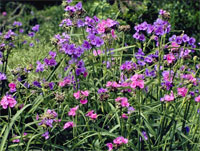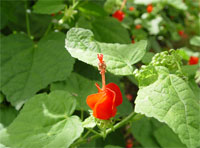Timesharing with Texas Native Plants

Turk’s cap (top) and giant spiderwort (bottom) can coexist nicely, each claiming its own showtime during the year.
Photos courtesy of Andrea DeLong-Amaya.
So, you had a lovely stand of lush Turk’s cap going all summer and into the fall, then winter hit and the first freeze of the season rendered it a sad bank of black herbage. You cut it back to nubs and now stare listlessly at the bare ground.
How can you keep your garden looking cheerful year ‘round? Employ a strategy of “timesharing.” By selecting species with similar growing requirements and different growing seasons, you can maximize the use of space you have under cultivation. Typically, herbaceous plants are either dormant in the winter and active in the warm season or active in the cool season and dormant in the summer. The tricky part is getting the timing right.
Here are a few winning combinations we’ve relied on at the Lady Bird Johnson Wildflower Center:
Turk’s cap (Malvaviscus arboreus var. drummondii) and giant spiderwort (Tradescantia gigantea): Turk’s cap emerges from dormancy in spring and sports scarlet blossoms throughout the summer. By the time hard frost takes out the Turk’s cap, the daylily-like winter foliage of spiderwort begins to wake up and grow actively through the winter, flaunting copious blue, purple, magenta, or white flowers all spring. Spiderwort disappears completely around May or June, giving the show back to the Turk’s cap.
Texas lantana (Lantana urticoides) and bluebonnet (Lupinus texensis): Texas lantana is a late sprouter in spring but carries off the warm seasons with cheerful yellow and orange flowers. Cold weather knocks it into dormancy for the winter, leaving room for bluebonnets to sprout. To get this combination to work best, cut back the lantana by November to allow bluebonnet seedlings to absorb as much sunlight as possible over the winter in preparation for the spring show.
Partridge pea (Chamaechrista fasiculata) and square-bud primrose (Calylophus berlandieri): A fast-growing summer annual, partridge pea features open and airy foliage which will not overly shade summer-dormant species like square-bud primrose, which blooms in spring and has nice winter foliage at ground level. Another summer-dormant, winter-evergreen, spring-blooming wildflower that works nicely with partridge pea is winecup (Callirhoe sp.).
Wild petunia (Ruellia humilis or R. nudiflora) and baby blue-eyes (Nemophila phacelioides): Purple, lavender, or white flowers of wild petunias are attractive to butterflies as well as visually appealing. They grow and bloom from spring to fall, then disappear for the winter. By seeding this area with baby blue-eyes, a winter annual that blooms in early to mid-spring, you can have winter cover and spring color.
If you find these great native species hard to find, encourage your local garden center to make them available, or find them at the Wildflower Center’s semi-annual plant sale and gardening festivals in April and October.
We are always looking for and experimenting with stalwart new combinations. If you have favorite Texas native plant combinations, please share them by contacting me at adelongamaya@wildflower.org.
For more information about Texas native plants, visit the Wildflower Center’s website at www.wildflower.org.
About the author: Andrea DeLong-Amaya is the director of horticulture at the Lady Bird Johnson Wildflower Center in Austin.


